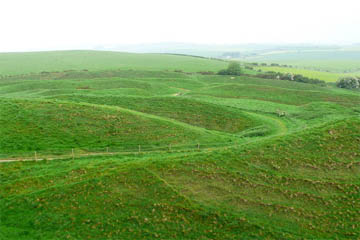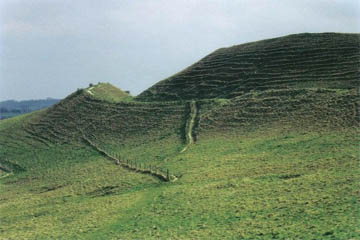Headless bodies stop wandering ghosts
It would be too much to say that Olympic fever has hit Britain - the initial delight that Britain's bid to host the 2012 Games was successful was lost in the noise of the bombs on London's Underground the following day - but work is proceeding apace on preparations for the Games. The Olympic Village is going to schedule (according to the government minister in charge), the promised velodrome is nowhere near complete and the work of clearing people out of their homes and businesses so that the Olympic stadium can be built is continuing.
Meanwhile down in Dorset - where Weymouth and Portland are to share the sailing events - the long-promised Weymouth Relief Road has been grandly renamed "Olympic Highway" and has finally made it off the drawing board and onto the ground.
Dorset is rich in history: one of its best known ruins is Corfe Castle, where young King Edward - known as "the Martyr" - was murdered by his step-mother. King Alfred set up his standard here at the start of his victorious campaign against the Danes and he got off to a good start by destroying a Viking fleet at Arne on the Isle of Purbeck, 120 fleeing ships being wrecked on Studland beach. The Tolpuddle Martyrs came from here and were transported to Australia for daring to set up a trades union.

|
| The overlapping earthworks in the east gate of Maiden Castle. |
Perhaps the most evocative of Dorset's ancient monuments, however, is the massive earthwork known as Maiden Castle. Built between 600 BC and 450 BC, the hill fort came to cover 47 acres and was surrounded by four banks and three ditches - one of which measured 28' from the bottom of the ditch to the top of the bank. When we consider that the bank may have been further reinforced with a wooden palisade, we can see what a formidable fortress this must have been.
In AD 43 the Romans came to Dorset, perhaps attracted by the flourishing iron industry in Maiden Castle - based on iron ore brought from Wales or the Weald. When Sir Mortimer Wheeler excavated the site in 1934-7 he discovered 28 graves containing 34 bodies buried by the east gate. The 23 men and 11 women had been hurriedly buried and injuries to the heads of some of them showed that they had met a violent end and may even have been deliberately mutilated after death. One skeleton actually had the head of a Roman ballista bolt embedded in his spine, which led Wheeler to postulate a massed attack by Roman legionaries, preceded by an artillery barrage, the capture of the fortress, the slaughter or enslavement of all inside and the deliberate destruction of the fortress by the victors.

|
| One of the banks that surrounds Maiden Castle in Dorset. |
There is a tendency these days to deprecate Wheeler's scenario. There is no evidence the bodies came from Maiden Castle, the critics claim, pointing out that the layers of charcoal that Wheeler interpreted as evidence of the castle being burned are, in fact, from the iron smelting operations. I must admit, though, that the ballista bolt looks pretty conclusive to me - I can't see the legionaries firing a ballista at a party of drunken revellers!
Now workmen on the Olympic Highway have found further support for Wheeler's thesis. As the road building machines cut into the earth on Ridgeway Hill they uncovered an ancient burial pit containing at least 45 bodies. Oddly, the skulls were nearly stacked at one end of the pit and only a few other bones have been found. These, however, indicate that, like one of the bodies Wheeler found, the limbs had been hacked off after death!
What is not clear is who buried the bodies. The presence of crude grave goods with the bodies found by Wheeler indicates that they were buried by friends or relatives who assured them of a safe journey into the nexrt world - Romans would not have taken so much trouble over the bodies of enemies!
It is possible that these newly discovered bodies were also buried by friends and that the removal of the heads and limbs had some sort of ritual purpose. On the other hand it is also possible that the bodies may represent young warriors captured by the Romans and executed by them. Beheading was a Roman method of execution - though usually reserved for Roman citizens and people of high rank; the ordinary criminal or rebel was crucified so that all might see his fate and fear.
Roman legions were commonly accompanied by auxilliaries who might come from any part of the world: Romans themselves would probably not mutilate the dead, but semi-savage tribesmen from an auxilliary unit, given the unpleasant task of murdering the prisoners might have removed their heads and limbs in order to prevent the unquiet spirits following them and seeking revenge!
Dorset county archaeologists are presently working on the scene and extending the 18' pit in the hope of discovering the missing body parts. The skeletons will be taken to Oxford for examination and analysis before eing returned to the Dorset County Museum where they will be displayed.
© Kendall K. Down 2009





